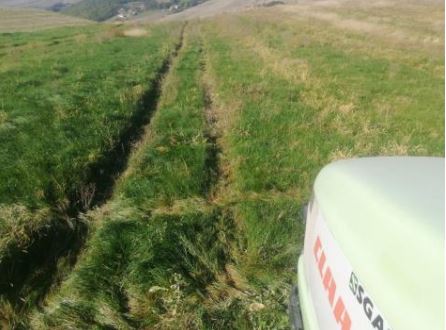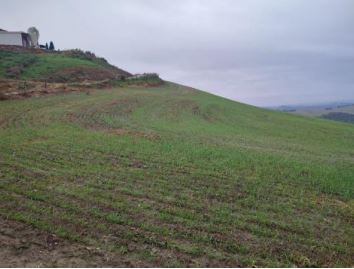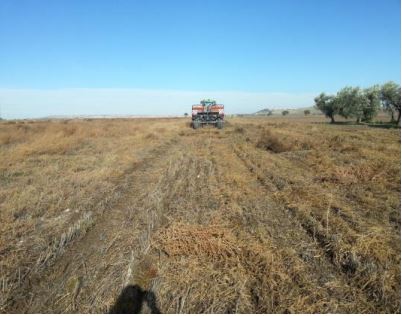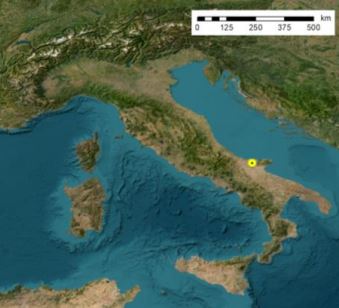Categories
Italy
Zannella’s Farm
Success Story
The Franco Zannella’s Farm is located in Candela, a small village in the province of Foggia (Apulia region, Italy). The farm has a surface area of 104 ha with 2 people as permanent staff. They are cultivating the following crops: durum wheat (Triticum durum L.), field bean (Vicia faba subsp. Minor), chickpea (Cicer arietinum L.), white clover (Trifolium repens L.), sunflower (Helianthus annuus L.). They apply soil conservation practices overall on the farm surface. Specifically, they have a sod seeding machine, therefore no-tillage management of the soil is carried out. Furthermore, they use some legumes for cover crop purposes, and they usually execute two-year rotations, alternating cereals, and legumes. The previous practices have been used from 2008 to the present (2022). They started to apply no-tillage because the soils of the farm became very poor with a low level of fertility as a consequence of deep soil works. The owner of the farm used to work as a tractor conductor for the plowing operations. He did not receive any training about the practice of soil conservation, but he learned the RA farming practices from agricultural websites and newspapers. Additionally, he did not receive any financial support to start soil conservation practices.
After the application of the RA practices, he experienced even higher grain yield compared to the previous years, better soil quality in terms of fertility as assessed by the number of earthworms in the first soil layers, a lower workload compared to the previous year, and a higher income; on the other hand, he pointed out the diffusion of weeds, especially Lolium, overall the field. For this reason, he decided to cultivate spring crops, such as sunflowers, but he highlighted the difficulty of growing sunflowers under no-tillage management. However, the farmer is very pleased to apply soil conservation practices as well as he wants to continue to apply them also because of the increasing costs of fuel.
LABELS: Italy, crop-production, no-tillage
Lanini’s farm
Success Story
The Giuseppe Lanini’s Farm is located in Mucigliano, a small municipality of Asciano in the province of Siena (Tuscany region, Italy). The farm has a surface area of 200 ha with 1 person as permanent staff and 2 people as temporary staff. In addition, the farmer works as a contractor and can cultivate 600 ha. They are cultivating the following crops: durum wheat (Triticum durum L.), barley (Hordeum vulgare L.), and different kind of clovers, mainly squarrosum and alexandrinum. Besides, the farm also includes livestock with almost 700 sheep. They apply soil conservation practices overall on the farm surface. Specifically, they carry out no-tillage management of the soil. They usually execute a four-year rotation, settling clover as the first-year crop followed by three-year cereals. In addition, they manage legumes with cover crop purposes. Anyway, a part of the sewage produced by sheep is used as fertilizer, while the other is sold.
The previous practices have been used from 2014 to the present (2022). They started to apply no-tillage because they had a very high cost for cultivation and low revenues from the sale of agricultural products. He received training on the practice of soil conservation from the company that sold him the sod seeding machine. However, he did not receive any financial support to start soil conservation practices. After the application of the soil conservation practices, he experienced a similar grain yield compared to the previous years, but with a lower workload and lower costs, in terms of fuel. Additionally, better soil quality was obtained in terms of fertility as assessed by the amount of organic matter and the number of earthworms in the first soil layers. Because of the lower workload, he was able to cultivate more land as compared to the previous years. On the other hand, he pointed out the diffusion of weeds, especially Lolium, overall the field; he solved the problem using Lolium as hay and applying the pre-emergence herbicide. Altogether, the farmer is very happy to apply soil conservation practices and he doesn’t want to change anything.
LABELS: Italy, crop-production, livestock, no-tillage
Grappi’s Farm
Success Story
The Luchino Grappi’s Farm is located in Pienza, a small village in the province of Siena (Tuscan region, Italy). The farm has a surface area of 165 ha with 3 people as permanent staff. They are cultivating the following crops: durum wheat (Triticum durum L.), olive (Olea europaea L.), field bean (Vicia faba subsp. Minor), chickpea (Cicer aretinum L.), and different types of clovers. The farmer applies organic cultivation techniques over the entire cropped surface.
They apply some of the practices of regenerative agriculture (RA), i.e. the application of crop rotation as well as the use of cover crops. Regarding soil tillage, they usually perform conventional plowing, but also they substitute it with disk harrowing. In addition, it is an organic farm, hence it cannot cultivate the same crop for two following years, and legumes are commonly used as cover crops; the previous practices are applied to the overall field, and although they have never heard about regenerative agriculture they apply them. No training was received for applying them. After the application of crop rotation as well as the use of cover crops, they experienced an increase in grain yield, better soil fertility, and a lower weed problem.
LABELS: Italy, crop-production, organic
Giuntoli’s Farm
Success Story
The Sante Giuntoli’s Farm is located in Troia, a small village in the province of Foggia (Apulia region, Italy). The farm has a surface area of 100 ha with 3 people as permanent staff. They are cultivating the following crops: durum wheat (Triticum durum L.), field bean (Vicia faba subsp. Minor), sunflower (Heliantus annuus L.), and chickpea (Cicer aretinum L.). They have also a small livestock breeding with 20 calves. They apply some of the practices of regenerative agriculture (RA) that are common to soil conservative practices. In particular, they apply a two-year crop rotation, alternating legumes and cereals. They also execute no-tillage soil management and use legumes as cover crops. They apply the abovementioned practices on the overall farm. Specifically, they started to apply previous practices in 2008, and they are still applying them in the present.
The farmer is an agronomist. In 1977, a Professor held a lesson about the benefits of sod seeding, therefore he was very passionate about it. Therefore. he started to apply it very roughly with old machines, but with the new machine for sod seeding ha has entirely converted his farm. He received training from some agricultural associations, but also from the company that sold him the sod seeding machine. However, he received financial support from some regional funds (330 €/ha). After the application of the soil conservative practices, he experienced an increase in gross production, soil organic matter, and soil fertility, but also a reduction of workload. On the other hand, he has had a problem with Lolium and he solved it with the use of a decision-supporting system (DSS). Altogether, the farmer is very happy to apply soil conservative practices.
LABELS: Italy, crop-production, crop-rotation
Bevere’s Farm
Success Story
The Roberto Bevere’s Farm is located in Lesina, a small village in the province of Foggia (Apulia region, Italy). The farm has a surface area of 36 ha with 5 people as permanent staff. They are cultivating the following crops: durum wheat (Triticum durum L.), common wheat (Triticum durum L.), barley (Hordeum vulgare L.), and field bean (Vicia faba subsp. Minor). Nowadays they don’t apply no-tillage management as they have had some problems with the contractor that was carrying out fieldwork. However, they apply a two-year crop rotation, alternating legumes, and cereals. In the past, they carried out no-tillage management in the overall field.
The no-tillage practice has been used from 2014 to 2019. They started to apply no-tillage because they are curious about the innovations. He did not receive training on soil conservative practices, but they have studied in some books. The farmer did not receive any financial support to start soil conservative practices. After the application of the soil conservative practices, he experienced a lower workload and lower costs, especially in terms of fuel, but also an improvement in terms of fertility. On the other hand, he obtained a lower grain yield with respect to previous years, but the lower yield was balanced by the lower costs for cultivation. Altogether, the farmer was very happy to apply soil conservative practices and in the future, he wants to re-apply with no-tillage management because of the high costs of conventional agricultural operations.
LABELS: Italy, crop-production, crop-rotation
Baccoleno Farm
Success Story
The Baccoleno Farm is located in Asciano, a small village in the province of Siena (Tuscany region, Italy). The farm has a surface area of 300 ha with 270 ha as a sowing area. The farm staff is composed of 2 people as permanent staff, 1 person as a temporary worker, and another person as temporary staff for the farmhouse. They are cultivating the following crops: durum wheat (Triticum durum L.), barley (Hordeum vulgare L.), oat (Avena sativa L.), field bean (Vicia faba subsp. Minor), Italian sainfoin (Hedysarum coronarium L.), Egyptian clover (Trifolium alexandrinum L.), trifolium squarrosum (Trifolium squarrosum L.), Crimson clover (Trifolium incarnatum L.). The farm adopts the principle of conservation farming throughout the farm surface, so also applies some of the practices of regenerative agriculture (RA), i.e. no-tillage management, keeping the residues on the soil, precision agriculture to reduce the agrochemical input, crop rotation, and cover crop sowing.
In 2017, he started to apply conservative agriculture (CA) practices and he still applies those practices nowadays. He started to apply the CA practices on a part of the farm; after he detected that no yield differences were obtained with respect to conventional agriculture, all the farm surface was converted to the previous practices. He also detected lower costs as compared to conventional agriculture. He did not receive any training about conservative practices he was self-taught, obtaining information from agricultural websites and other farmers; no training was provided from the regional as well as from agricultural technicians. However, he received financial support to start soil conservative practices from the Tuscany region through Rural Development Program (PSR). As I previously mentioned, he detected lower production costs resulting from lower fuel consumption as compared to conventional agriculture, lower wear and tear on agricultural machines, less labor use and more free time for the farmer, soil protection against erosion, and improved soil organic matter. On the other hand, he claimed about the lack of training on the previous practices as well as about the skepticism from other farmers; he overcame previous through the advice of other farmers and advice on agricultural websites. To sum up, the farmer is very happy to apply soil conservative practices, but he wants to introduce some changes in conservative practices methods because of soil compaction as the soil of his farm is very heavy and tenacious.
LABELS: Italy, crop-production, conservative agriculture







